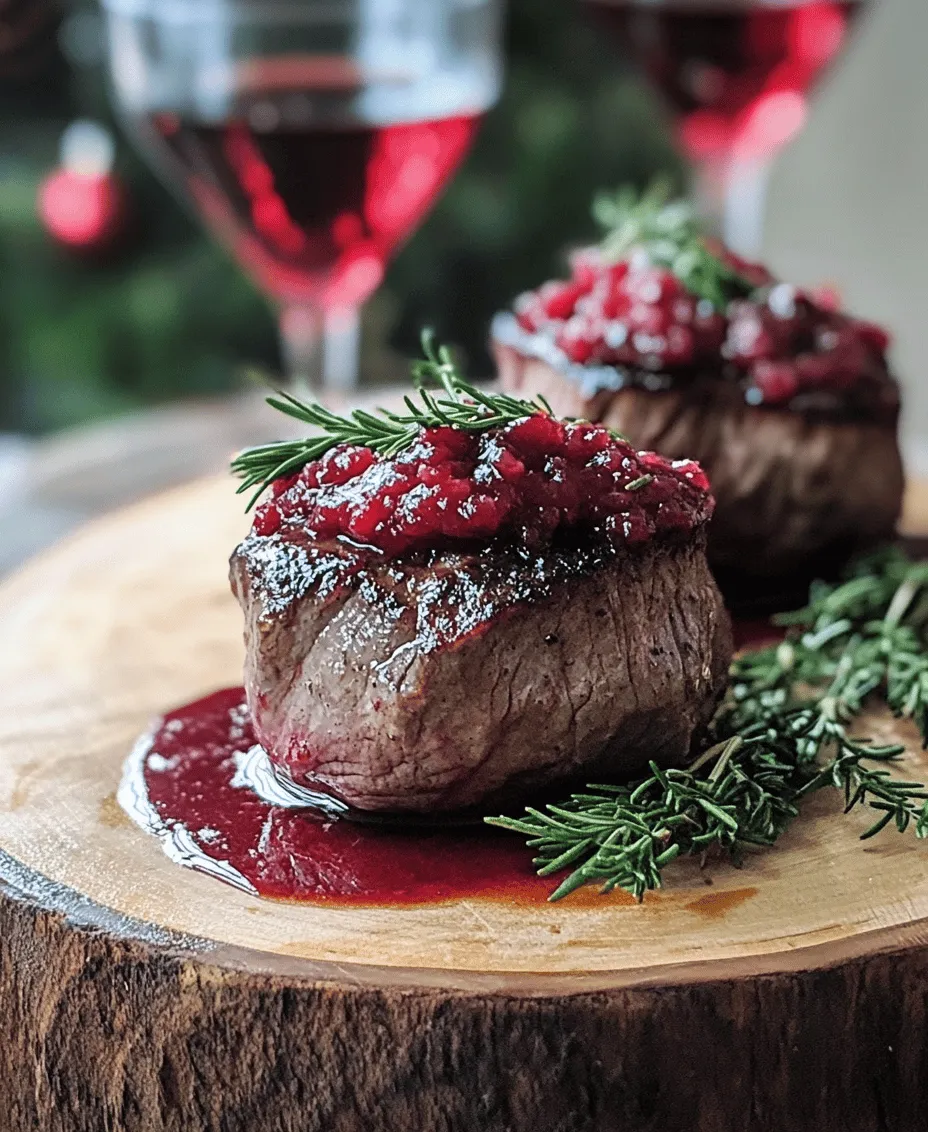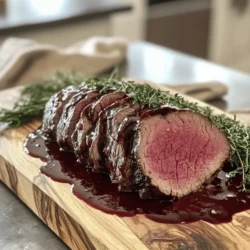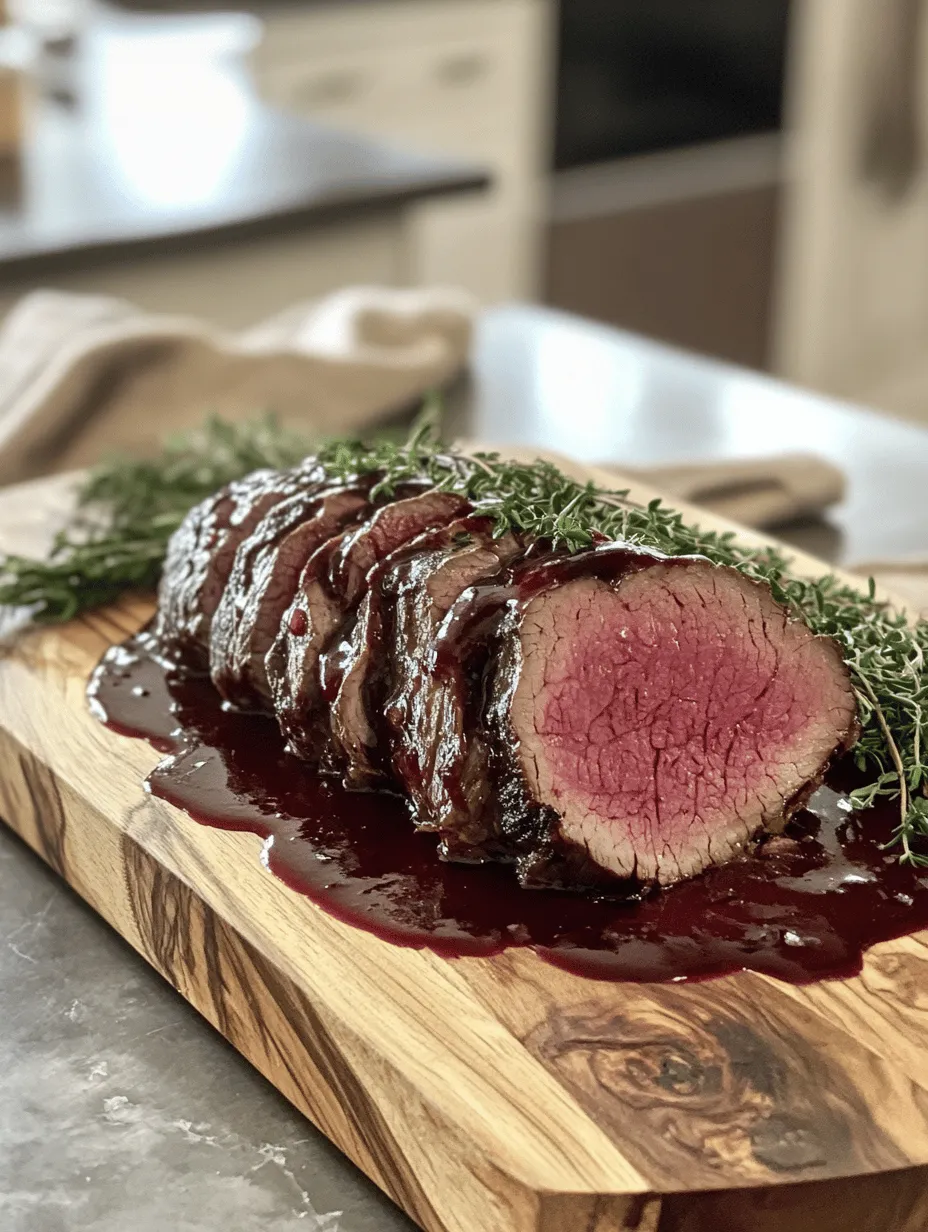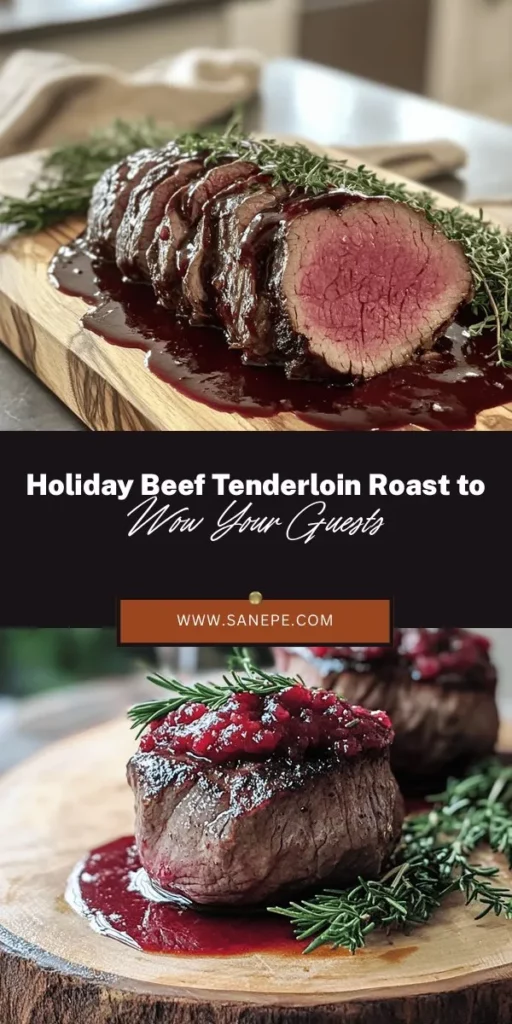Introduction
As the holiday season approaches, many of us find ourselves preparing for festive gatherings that center around sumptuous meals and delightful company. Among the various dishes that grace our tables, the beef tenderloin roast stands out as a true showstopper. This luxurious cut of meat not only exudes elegance but also offers an unparalleled depth of flavor that makes it a favorite for special occasions. Whether you’re hosting a family reunion, a holiday dinner, or a celebratory feast, a perfectly cooked beef tenderloin roast can elevate your dining experience to new heights.
The significance of this dish in festive dining lies not just in its taste but also in its ability to bring people together. A beautifully presented beef tenderloin roast serves as the centerpiece of any meal, inviting admiration and anticipation from your guests. However, achieving that restaurant-quality roast at home requires attention to detail, especially when it comes to selecting high-quality ingredients and mastering the cooking techniques involved. In this article, we will guide you through every step of crafting a Festive Beef Tenderloin Roast Extravaganza, ensuring that your culinary creation is nothing short of extraordinary.
Understanding Beef Tenderloin
Before delving into the specifics of our festive roast, it’s essential to understand what beef tenderloin is and why it has earned its place at the heart of special occasion dining. Beef tenderloin is a cut of meat derived from the loin of the cow, nestled along the spine. Renowned for its tenderness, it is one of the most sought-after cuts of beef due to its rich flavor and buttery texture, making it a staple in upscale dining.
One of the primary reasons beef tenderloin is favored for celebrations is its nutritional profile. This cut is not only delicious but also packed with protein, essential vitamins, and minerals. A typical serving of beef tenderloin is rich in iron, zinc, and B vitamins, which are vital for maintaining energy levels and overall health. However, with great flavor and nutrition comes the responsibility of choosing the right cut to ensure the best dining experience.
When selecting beef tenderloin, quality is paramount. Here are some tips for choosing the perfect cut at your butcher or grocery store:
1. Look for Marbling: Marbling refers to the small flecks of fat interspersed within the muscle. A well-marbled beef tenderloin will be juicier and more flavorful after cooking.
2. Check for Color: The meat should have a bright, cherry-red color. Avoid cuts that appear brown or dull, as these may indicate age or improper handling.
3. Consider the Grade: If available, opt for USDA Prime or Choice grades, which are known for their superior quality. Prime cuts are particularly tender and flavorful, making them ideal for this festive dish.
4. Ask the Butcher: Don’t hesitate to engage with your butcher. They can provide insights on the best available cuts and may even offer to trim the tenderloin to your specifications.
Ingredients Breakdown
Now that you have a solid understanding of beef tenderloin, let’s explore the ingredients that will bring our Festive Beef Tenderloin Roast Extravaganza to life. Below is a detailed breakdown of each ingredient and its role in the recipe:
1. Beef Tenderloin: As the star ingredient, the quality of the beef tenderloin you choose will significantly influence the overall flavor and tenderness of the roast.
2. Olive Oil: Used for rubbing the meat, olive oil helps to create a crust during the searing process. It also enhances the flavor and moisture of the roast.
3. Fresh Herbs: A combination of rosemary, thyme, and parsley adds aromatic flavors to the beef tenderloin. Fresh herbs elevate the dish, providing a fragrant and earthy balance to the richness of the meat.
4. Garlic: Fresh garlic cloves, minced or crushed, infuse the beef with robust flavor, enhancing its natural taste.
5. Salt and Pepper: These fundamental seasonings are essential for bringing out the flavors of the beef. A generous seasoning of kosher salt and freshly ground black pepper creates a delicious crust that contrasts beautifully with the tender interior.
6. Red Wine: A quality red wine, such as Cabernet Sauvignon or Merlot, will be used to deglaze the pan and create a sumptuous sauce. The wine adds depth and complexity to the dish, and its acidity helps to balance the richness of the beef.
7. Beef Broth: Used in conjunction with the red wine, beef broth contributes umami richness to the sauce, enhancing the overall flavor profile.
8. Butter: A small amount of butter adds a silky smoothness to the sauce, enriching the flavors and providing a luxurious finish.
By carefully selecting each ingredient, you ensure that your beef tenderloin roast is not only delicious but also memorable. The use of fresh herbs and high-quality red wine will significantly enhance the flavors, providing your guests with a truly indulgent experience.
Preparation Steps for Success
Once you have gathered all your ingredients, it’s time to begin the preparation process. Proper preparation is crucial for achieving a perfect roast, and that starts with the beef tenderloin itself. Here are the initial steps to set you up for success:
1. Patting the Meat Dry: Before seasoning, start by patting the beef tenderloin dry with paper towels. Removing excess moisture ensures better browning during the searing process, leading to a more flavorful crust.
2. Seasoning Generously: After drying, season the tenderloin liberally with kosher salt and freshly ground black pepper. Don’t be shy—this step is essential for enhancing the natural flavors of the meat.
3. Rubbing with Olive Oil: Next, drizzle olive oil over the beef tenderloin, ensuring it is evenly coated. This not only helps the seasonings adhere to the meat but also promotes a beautiful sear.
4. Applying Herbs and Garlic: In a small bowl, combine your minced garlic and chopped fresh herbs. Rub this mixture all over the tenderloin, ensuring every inch is covered. The flavors from the herbs and garlic will permeate the meat as it cooks, creating an irresistible aroma.
5. Visual Cues for Searing: To know when your tenderloin is ready to be seared, look for a slightly tacky texture on its surface. The seasoning will adhere beautifully, and the olive oil will create a sheen that signals it’s time to move on to the next cooking stage.
Searing the Beef Tenderloin
Searing the beef tenderloin is a vital step that cannot be overlooked. This technique not only develops deep, rich flavors but also creates a beautiful crust that seals in the juices. Here’s how to effectively sear your tenderloin:
1. Choosing the Right Equipment: Use a heavy-bottomed skillet or roasting pan that can withstand high heat. Cast iron or stainless steel pans are ideal for achieving a perfect sear. Ensure your pan is preheated over medium-high heat before adding the beef.
2. Searing the Meat: Once the pan is hot, carefully place the seasoned beef tenderloin in the skillet. Allow the meat to sear undisturbed for about 3-4 minutes on each side. You are looking for a rich, brown crust to form, which will create a delightful contrast to the tender interior.
3. Using Tongs for Handling: As you sear, use tongs to gently turn the tenderloin. Avoid using a fork, as piercing the meat can cause valuable juices to escape, resulting in a drier roast.
4. Final Touches: After searing all sides, you’ll be ready to transfer your tenderloin to the oven for roasting. This combination of stovetop searing and oven roasting will culminate in a beautifully cooked beef tenderloin, perfectly tender and packed with flavor.
By understanding these initial steps and the significance of each ingredient, you are well on your way to creating a Festive Beef Tenderloin Roast Extravaganza that will impress your guests and create lasting memories. The journey to mastering this exquisite dish is just beginning, and the end result promises to be a celebration of flavor and festivity. Stay tuned as we delve into the subsequent steps of roasting, sauce preparation, and presentation in the next part of this culinary journey.

Tips on Achieving the Perfect Crust Without Overcooking the Meat
Creating a delicious beef tenderloin roast is not just about the quality of the meat; it’s also about mastering the technique to achieve that coveted crust while keeping the inside juicy and flavorful. Here are some essential tips to help you achieve the perfect balance:
1. Pat the Meat Dry: Before seasoning, thoroughly pat the beef tenderloin dry with paper towels. A dry surface will help you achieve a better sear and crust.
2. Use High Heat: Start the roasting process at a high temperature (around 450°F or 232°C) for the first 15-20 minutes. This initial high heat will help form a crust that locks in the juices.
3. Sear Before Roasting: For an even deeper flavor, consider searing the tenderloin in a hot skillet with a little oil before transferring it to the oven. Sear each side for about 3-4 minutes until a brown crust forms.
4. Monitor Internal Temperature: As you roast, use a meat thermometer to keep an eye on the internal temperature. This will prevent overcooking. The ideal temperature for medium-rare is 135°F (57°C).
5. Carryover Cooking: Remember that the meat will continue to cook after it’s removed from the oven, known as carryover cooking. Plan to take it out when it is about 5°F (3°C) below your desired doneness.
Roasting Techniques
Roasting a beef tenderloin to perfection requires careful attention to time and temperature. Here’s a detailed guide to help you navigate through the process:
1. Roasting Times and Temperatures:
– Rare: 120-125°F (49-52°C) — approximately 20-25 minutes per pound.
– Medium-Rare: 130-135°F (54-57°C) — approximately 25-30 minutes per pound.
– Medium: 140-145°F (60-63°C) — approximately 30-35 minutes per pound.
– Medium-Well: 150-155°F (66-68°C) — approximately 35-40 minutes per pound.
– Well Done: 160°F (71°C) and above — approximately 40-45 minutes per pound.
2. Using a Meat Thermometer: Invest in a good-quality meat thermometer. Insert it into the thickest part of the tenderloin, avoiding any bones or fat. This will provide the most accurate reading of the meat’s internal temperature.
3. Resting the Meat: Once the meat reaches your desired temperature, remove it from the oven and let it rest for at least 15-20 minutes before slicing. Resting allows the juices to redistribute throughout the meat, ensuring every bite is succulent and tender.
Creating the Red Wine Sauce
A rich red wine sauce can elevate your festive beef tenderloin roast to gourmet status. Making the sauce in the skillet you used for the roast will maximize flavor through the fond (the browned bits) left behind. Follow these steps for a delicious sauce:
1. Ingredients:
– 1 cup red wine (such as Cabernet Sauvignon)
– 1 cup beef stock
– 2 tablespoons unsalted butter
– 1 shallot, finely chopped
– Salt and freshly cracked black pepper, to taste
2. Step-by-Step Guide:
– After removing the roast, place the skillet over medium heat.
– Add the chopped shallot to the skillet, sautéing until translucent, about 2-3 minutes.
– Pour in the red wine, scraping the bottom of the pan to deglaze and incorporate the fond.
– Allow the wine to simmer and reduce by half, which should take about 5-7 minutes.
– Add the beef stock and continue to simmer until the sauce thickens, about 10 minutes more.
– Remove from heat and whisk in the butter for a glossy finish. Season with salt and pepper to taste.
3. Achieving the Perfect Consistency: For a thicker sauce, let it reduce longer. If it becomes too thick, you can always whisk in a bit more beef stock to reach your desired consistency.
Presentation and Serving Suggestions
The presentation is key to making your festive beef tenderloin roast a showstopper. Here are some creative ideas for slicing and serving:
1. Slicing the Beef: Use a sharp carving knife to slice the beef against the grain into 1/2-inch thick slices. This will ensure tenderness in each bite and enhance the overall presentation.
2. Plating Ideas: Arrange the slices in a fan shape on a warm platter. Consider layering them slightly for a more dynamic look. Drizzle the red wine sauce over the beef and around the plate for an artistic touch.
3. Complementary Side Dishes: Enhance your meal with side dishes that complement the richness of the beef. Some excellent choices include:
– Creamy mashed potatoes or garlic mashed potatoes.
– Roasted seasonal vegetables, like Brussels sprouts or carrots.
– A fresh arugula salad with shaved Parmesan, lemon vinaigrette, and nuts for a refreshing contrast.
4. Garnishing: Finish your dish with sprigs of fresh herbs like rosemary or thyme. This not only adds visual appeal but also enhances the aroma and flavor of the dish.
Pairing Wine with Your Festive Meal
Selecting the right wine to pair with your beef tenderloin roast can elevate the dining experience. Here are some recommendations:
1. Wine Recommendations:
– Cabernet Sauvignon: This bold red wine is a classic pairing with beef, offering rich tannins that complement the meat’s flavors.
– Malbec: Known for its dark fruit flavors and velvety texture, Malbec works wonderfully with roasted meats.
– Pinot Noir: If you prefer a lighter wine, a Pinot Noir provides a delightful acidity that can cut through the richness of the beef.
2. Selecting Wine Based on Taste: Consider your personal preferences. If you enjoy bolder flavors, opt for a Cabernet Sauvignon. For a more delicate palate, a Pinot Noir may be more to your liking. Always choose a wine that you would enjoy sipping on its own.
Conclusion
The Festive Beef Tenderloin Roast is more than just a meal; it’s a centerpiece that brings family and friends together to celebrate special occasions. With its tender and juicy meat, complemented by a rich red wine sauce, it promises to impress and delight at any gathering.
We encourage you to give this recipe a try, embrace the joy of cooking, and share the experience with your loved ones. Preparing meals from scratch not only nurtures the body but also enriches relationships, creating memories that last a lifetime. So, roll up your sleeves, gather your ingredients, and embark on a culinary adventure that will bring warmth and happiness to your festive table.


